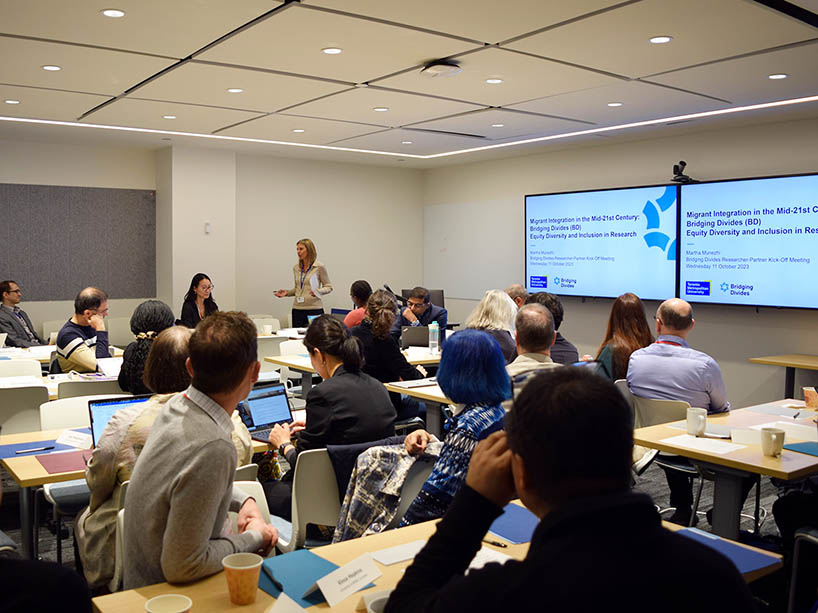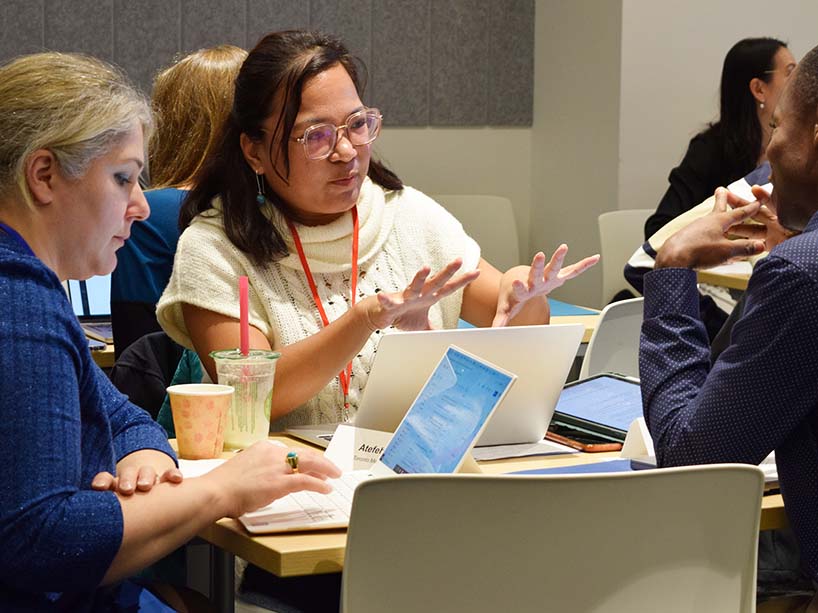Massive immigration research team set to make waves in Canadian integration policy

Anna Triandafyllidou, Canada Excellence Research Chair in Migration and Integration, and scientific director of the Migrant Integration in the Mid-21st Century: Bridging Divides program, and Zhixi Cecilia Zhuang, urban and regional planning professor and director, DiverCity Lab, at a recent Bridging Divides meeting.
Back in April, TMU announced that it had received a prestigious $98.6 million grant from the Canada First Research Excellence Fund (CFREF) to lead a multi-institutional, interdisciplinary research initiative to study immigration, integration and how technology can be leveraged in a time of social and economic transformation.
It’s the single largest research grant TMU has received to date, and Anna Triandafyllidou, Canada Excellence Research Chair in Migration and Integration and scientific director of the Migrant Integration in the Mid-21st Century: Bridging Divides program, is taking a moment to recognize the accomplishment. “We’re proud because of the size and ambition of the research program. It’s not often that you get this kind of funding in the social sciences and in migration research,” she says. “So it’s important to celebrate both on the part of the federal government and on the part of TMU, for leading this.”
The seven-year Bridging Divides research program is now underway, with 25 research leads and more than 100 scholars – from TMU, Concordia University, UBC and University of Alberta – working collaboratively under four major themes:
- Immigrant health and well-being: Employing innovative social and technological strategies and tools to engage immigrant communities in prioritizing needs and co-creating solutions to reduce health disparities.
- Place and infrastructure: Exploring how smart city technologies can reinforce social infrastructure to optimize the resilience of urban communities.
- Employment and lifelong learning: Examining whether and how advanced digital technologies can be strategically applied to improve immigrants’ economic integration.
- Citizenship and participation: Considering how advanced digital technologies affect civic and political participation and how they can be harnessed to build resilient, inclusive and sustainable communities.
Canada’s challenges and opportunities

Atefeh (Atty) Mashatan, Canada Research Chair and director of the Cybersecurity Research Lab, is working with her colleagues from partner universities, including Ethel Tungoha from York University and Abdul-Fatawu Abdulai from the University of British Columbia.
This project gives the large research team a chance to zero in on Canada’s position as an immigrant-receiving country.
“Canada is actually trying to select immigrants,” says Rupa Banerjee, lead for the employment and lifelong learning theme. “Because of our geography, we don’t have a lot of asylum seekers or people presenting at our doors. We have natural barriers on two sides and the U.S. on the other side, so our immigration policy is much more proactive, similar to what we’d see with Australia.”
Post-pandemic, Canada has leaned on immigration as its central strategy for growth and economic rehabilitation, says Banerjee. Because of this, the massive Bridging Divides team has a real research opportunity here in Canada.
“Canada is a real life lab and I think some of our research can inform what happens in other countries,” says Triandafyllidou. “Although we currently have good data, I think we can get even more focused, to understand how things are evolving. We’ll be producing a lot of usable knowledge that policymakers, politicians and even activists can use to inform their suggestions.”
Four themes, working together
“Our entire project is called ‘bridging divides’ – it’s about integration,” says Josephine Wong, professor within the Daphne Cockwell School of Nursing, and lead on the immigrant health and well-being theme. “So when we talk about bridging, there are many places that we need to bridge. And from a health perspective, we're focusing on the conditions and determinants of health and health inequities. Even though there are four themes, the theme of health and well-being is connected to all the other themes.”
Triandafyllidou, who is also leading the citizenship and participation theme, calls the approach a 360 degree process and says they are working collaboratively with non-academic partners as well to get on-the-ground insight.
“We want our non-academic partners’ views on what's important for them in this bigger research program,” she says. “One element that came up was the opportunity to use the data that civil society organizations may collect as part of their routine work, but don't have the capacity to analyze. Our research program has the potential to review this data and provide deeper insights about their work and programming.”
Banerjee, who is also the Canada Research Chair in economic inclusion, employment and entrepreneurship of Canada’s immigrants, echoes Triandafyllidou. “It’s a very collaborative process, we’re working with academic partners who have their ear to the ground, and our non-academic collaborators and partners who are often in the settlement service sector or the policy sector,” she says. “Our theme teams have been talking about what kind of initiatives have worked, and whether there are projects or initiatives that are being implemented at a local or regional level that are working, and how technologies can potentially scale those up.”
For Wong and her theme team, moving their work forward to community policy action is important. “We’re looking at how to engage the community to take part in policy action and influence policy change,” she says. “We want to find methods so that it's easy for people who are most affected by certain issues to actually have a part to play. This is really about what policymakers can learn from the grassroot voices.”
Technology driving change
Bilal Farooq, Canada Research Chair in disruptive transportation technologies, says the theme he’s leading, place and infrastructure, is examining how technology can provide solutions-based approaches to the challenges Canada is facing.
“Transportation systems are among the most important infrastructure in an urban area. It’s what we call a connector system, these systems are key to our living in a particular area,” he says.
His team has a sub-theme devoted specifically to looking at transportation and technology – one they’re calling cyber physical infrastructure. “There is a physical dimension to our lives and where we live – paved roads and vehicles and so on. But there's a digital layer on top of them as well, now we have mobility apps such as Uber. This cyber physical infrastructure is extremely important for urban areas. We’re looking at whether what exists is relevant for the integration of new Canadians.”
Like the other three leads, Farooq says he’s focused on solutions. “We want to develop mathematical models of behaviours and interactions around which we can develop a digital twin of an urban area for ‘what if’ scenario analysis,” he says.
In examining participation and citizenship, Triandafyllidou can see several examples of how technology might be leveraged for positive outcomes. “We've seen technology has been very important in processing the backlog of citizenship applications,” she says. It could also lower social and economic barriers for migrants, including foreign credential recognition. “Augmented reality tools, for instance, may allow some professionals to complete retraining and accreditation procedures from their country of origin instead of in Canada.”
She says that the team’s emphasis on the role of technology will bring some new insights – both empirical and analytical – to how integration is happening and what belonging really means. Banerjee agrees, saying the focus on technology has the potential to shine light on some tangible solutions for big issues in integration of newcomers.
“We know that despite the carefully calibrated selection system, newcomers face significant barriers in the labour market, and often don't ever re-enter their field of expertise. On the supply side, some studies show that newcomers tend to score lower than Canadian-born individuals in aspects such as soft skills,” she says.
“And on the demand side, we know that implicit bias is real. We know that employers tend to discriminate on a number of factors that really disadvantage immigrants – name- and accent-based discrimination. So we’re looking at how we could leverage technologies to actually improve employers’ assessment of credentials, for example. There's a lot of potential for new technologies to be used at every stage of the immigration process so that newcomers can hit the ground running instead of starting their integration process after landing.”
Having an impact
The entire team says that they think the research program has the potential to produce multilayered outcomes that will impact individuals, communities and policy-makers.
“Canada is often touted as a leader in immigrant integration,” says Banerjee. “So I hope we can make some contribution to the theoretical model of how immigrants actually settle and integrate into societies.”
From a practical perspective, she thinks her team can provide a lot of perspective on how things can be done better. “I have a lot of optimism around how we can include and involve all stakeholders, including employers, higher education institutions and all other peripherally related bodies like occupational licensing in this process of enabling immigrants to integrate, so it's a whole society approach, rather than relegating the responsibility to immigrants.”
Farooq has the same optimism. “The digital twin approach that we are developing to run simulations is something that could be readily used by municipalities, and we'll be working very closely with them to define the kinds of scenarios that should be simulated,” he says. “So the outputs that come out of it could be useful for policy-making.”
To read the latest news and updates on the project, visit the Bridging Divides news site.
Related: